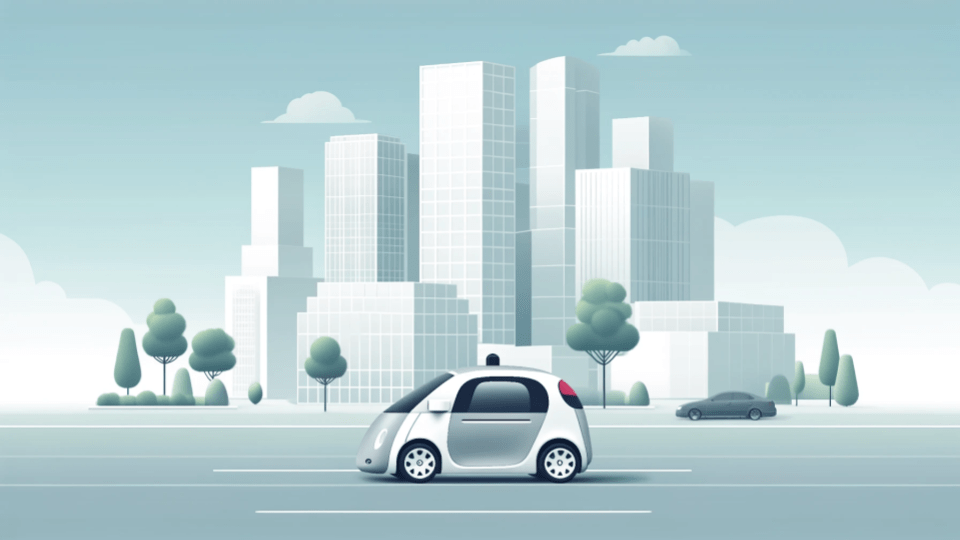The What is what of Autonomous Vehicles
Autonomous vehicles (AVs), also known as self-driving cars or automated cars, represent a significant leap forward in automotive technology. These vehicles are equipped with advanced sensors, cameras, and artificial intelligence, allowing them to navigate and operate without human intervention.

The interest in Autonomous Vehicles technology is rapidly growing. A significant segment of car buyers are highly interested in autonomous driving features, with a considerable portion willing to pay a premium for advanced capabilities. For instance, one-quarter of car buyers express high interest in autonomous features, with two-thirds of this group prepared to pay up to $10,000 extra for these advanced technologies (Autonomous Vehicles | McKinsey).
Technological Impact
AVs are set to transform various industries by automating transportation and reducing operational costs. For example, autonomous and smart vehicles are already operational in controlled environments like warehouses and are piloted on public streets in Europe and North America. These developments not only lead to cost reductions but also improve lead times and lower environmental impacts (Supply Chain 4.0 | McKinsey).
Market Dynamics
The market for AVs is driven by both consumer interest and technological advancements. Investments in automotive technology continue to show robust growth, with significant capital flowing into the development of next-generation automotive solutions. This reflects a strong belief in the long-term value potential of these technologies.
Educational and Workforce Transformations
As autonomous technologies evolve, there is a parallel shift in educational needs and workforce dynamics. The demand for tech-savvy professionals capable of working with complex, automated systems is rising. Educational institutions and companies are increasingly focusing on continuous learning and upskilling to meet these new demands (Future Trends | McKinsey).
This introduction lays the groundwork for understanding how autonomous vehicles are reshaping transportation, impacting economic sectors, and transforming professional landscapes. As we delve deeper into the workings and implications of AVs in subsequent sections, we’ll explore how these technologies are poised to redefine our approach to mobility and connectivity.
How Do Autonomous Vehicles Work?
Autonomous vehicles function through a complex system of sensors, cameras, and artificial intelligence (AI) that enables them to perceive their surroundings and make decisions without human intervention. Here’s how this technology comes together to operate:
Perception and Sensing
They use a combination of cameras, radar, and LiDAR (Light Detection and Ranging) to create a detailed 360-degree view of their environment. This setup allows the vehicle to detect and navigate around obstacles, monitor traffic conditions, and adhere to road signs and lane markings. The radar system provides valuable data on the speed and distance of objects, while LiDAR offers precise depth perception, crucial for understanding the vehicle’s surroundings in three dimensions.
Data Processing and Decision Making
The heart of an AV’s operation lies in its onboard computers equipped with advanced AI algorithms. These computers process vast amounts of data collected from the vehicle’s sensors to build a dynamic map of its environment. Using this map, the AI makes decisions in real time, such as when to accelerate, brake, or steer. This decision-making process is based on complex algorithms that predict the behavior of other road users and adjust the vehicle’s actions accordingly.
Navigation and Control
Once the AI has processed the data and made its decisions, these instructions are sent to the vehicle’s actuators, which control the steering, braking, and throttle. This system allows the AV to execute maneuvers smoothly and accurately. Additionally, they are equipped with sophisticated software that enables route planning and navigation, factoring in variables like traffic conditions and road work, to determine the optimal path to the destination.
Continuous Learning and Adaptation
They are not static systems; they are designed to learn and improve over time. Through a process known as machine learning, they use data gathered during their journeys to enhance their decision-making algorithms and adapt to new scenarios. This continuous learning process is crucial for improving the safety and efficiency of operations.
Industry 4.0 Integration
In the broader context of Industry 4.0, they represent a significant shift towards more connected and intelligent systems in transportation. They integrate seamlessly with other smart technologies, enhancing efficiency and sustainability. These vehicles are part of a larger ecosystem that includes smart infrastructure and data analytics, which together drive forward the innovation in mobility and urban planning.
They are a prime example of how technological advancements are reshaping industries by integrating digital information from various sources to enhance operational efficiency and meet modern demands.
Understanding Levels of Vehicle Autonomy
The Society of Automotive Engineers (SAE) has defined six levels of driving automation, ranging from Level 0 (no automation) to Level 5 (full automation). Each level describes the extent to which a vehicle can take over driving tasks from a human (SAE International).
Level 0: No Driving Automation
At this level, the vehicle has no automation features; the driver controls all aspects of driving at all times, though there may be some basic driver assistance systems like emergency braking.
Level 1: Driver Assistance
Here, the vehicle features single-function automation, such as adaptive cruise control or lane keeping assistance, but the driver must remain engaged and monitor the environment at all times.
Level 2: Partial Driving Automation
Vehicles at this level can simultaneously take over multiple tasks like acceleration and steering using systems like advanced cruise control combined with lane centering. The driver is still required to stay alert and ready to take control.
Level 3: Conditional Driving Automation
At Level 3, the vehicle can manage all aspects of driving in certain conditions, such as on highways or in traffic jams, without human intervention. However, the driver must be ready to intervene if the system requests it.
Level 4: High Driving Automation
Vehicles at this level can handle all driving tasks in specific environments, such as urban areas or dedicated routes, without any driver intervention. Importantly, if there is a system failure or the conditions become too challenging, the vehicle can safely handle the situation without any human input.
Level 5: Full Driving Automation
This is the highest level of driving automation. At Level 5, the vehicle is capable of performing all driving functions independently under all conditions. No human intervention is required at any point, and there may not even be driving controls in the vehicle.
These levels help clarify the capabilities and limitations of autonomous technology as it progresses. While advancements are rapid, the full realization of Level 5 autonomy across diverse conditions remains a goal yet to be achieved.
Understanding these levels is crucial for both consumers and developers as they navigate the implications of autonomous technologies on road safety, legal frameworks, and insurance.
Technological Advances and Key Players of Self-driving cars
The field of autonomous vehicles is advancing rapidly, driven by significant technological innovations and the involvement of key industry players. Here’s an overview of the latest developments and the companies leading the way.
Technological Advances
The core technologies propelling them include artificial intelligence (AI), machine learning, and an array of sensors such as LiDAR, radar, and cameras. These technologies allow vehicles to perceive their environment, make decisions, and navigate without human input. Advances in AI, particularly generative AI, are enhancing the capability of autonomous systems to handle complex scenarios and improve over time through data accumulation and learning (Disruptive technologies | McKinsey).
Energy storage and management technologies are also crucial, as they enable longer operation times for electric AVs. Innovations in battery technology and energy management systems are helping to make them more practical and affordable.
Key Industry Players
Leading the charge are companies like Tesla, Waymo, and Cruise, among others. Tesla continues to innovate in both autonomous technology and electric vehicle manufacturing. Waymo, a subsidiary of Alphabet, is at the forefront of developing fully autonomous driving technology and has been conducting extensive tests on public roads. Cruise, backed by General Motors, is also a major player, focusing on creating a fully integrated autonomous ride-sharing service.
These companies are not only advancing the technology but are also shaping the regulatory and consumer landscapes. They work closely with regulators to ensure safety standards and are pivotal in driving consumer adoption through continuous improvement of AV capabilities and safety features.
Future Outlook
The future looks promising for AVs with ongoing technological enhancements and increased investment. The sector is expected to grow significantly as more players enter the market and collaborations increase between traditional automakers and tech companies. This growth is underpinned by substantial investments from both private and public sectors, aiming to push the boundaries of what AVs can achieve.
Market Dynamics and Consumer Adoption of Autonomous Vehicles
The market dynamics of autonomous vehicles are influenced heavily by advancements in artificial intelligence (AI), which is increasingly becoming a pivotal element in driving consumer adoption and technological improvements in the sector.
Technological Impact of AI on AVs
AI’s role in enhancing the capabilities of autonomous vehicles cannot be overstated. From improving navigation systems to making real-time driving decisions, AI technologies such as machine learning and deep learning are at the core of AV operations. These AI systems process vast amounts of data from vehicle sensors to enhance safety and efficiency, making them more attractive to consumers and businesses alike. The integration of AI continues to evolve, promising even greater advancements that could increase the adoption rates of AVs.
Consumer Adoption Trends
Consumer adoption of AVs is on the rise, facilitated by a growing trust in the technology and an appreciation for the convenience and safety features that AVs offer. Key factors influencing adoption include the perceived reliability of autonomous systems and the comfort level of users with the technology. As AI technology improves, making AVs more capable and reliable, consumer confidence is expected to grow, which will drive further adoption.
Moreover, the COVID-19 pandemic has accelerated the shift towards digital and remote capabilities, affecting consumer behaviors and expectations. This shift is likely to increase interest in innovative technologies like AVs, as consumers become more accustomed to technology-driven solutions (The future of work after COVID-19 | McKinsey).
Market Growth and Investment
Investment in AI and AV technology remains robust, reflecting a strong belief in the future growth potential of these sectors. Despite fluctuations in tech investment trends, the foundational AI technologies driving advancements continue to attract significant capital, underscoring the confidence investors have in the transformative potential of AI in the automotive industry. This ongoing investment is crucial for the development and refinement of AI technologies that are essential for the evolution of autonomous vehicles.
Future Outlook
The future looks promising, with AI playing a critical role in shaping the landscape. As AI technology advances, we can expect to see more sophisticated AVs that offer greater safety and efficiency. Consumer adoption is likely to increase as the technology proves its value in terms of convenience, safety, and accessibility.
Challenges and Future Prospects of Autonomous Vehicles
Technological and Regulatory Challenges
Autonomous vehicles face a mix of technological and regulatory challenges that could influence their future development and adoption. Technologically, the integration and reliability of advanced systems like AI pose significant challenges. These systems must flawlessly interpret vast amounts of data in real-time to ensure safety and functionality under diverse conditions.
Regulatory hurdles also present a significant barrier. The lack of unified standards and regulations across different regions can complicate the deployment of autonomous vehicles on a global scale. Regulatory bodies are tasked with balancing innovation with public safety, which often leads to a cautious approach that can slow down progress.
Market Acceptance and Societal Impact
Market acceptance remains uncertain, as consumer trust in fully autonomous technologies is still developing. The shift from human-controlled to entirely machine-controlled vehicles involves significant changes in public perception and behavior. This transition is complicated by high-profile mishaps and accidents, which can setback consumer acceptance and delay regulatory approvals.
Additionally, their impact on employment, particularly in driving-based professions, poses societal challenges. There is a potential for significant job displacements, which creates a need for retraining and redeploying the workforce to new roles, especially in technologically advanced sectors.
Environmental Considerations
On the environmental front, while they promise to reduce emissions through more efficient driving patterns, their actual environmental impact remains a subject of ongoing research and debate. The production and disposal of high-tech components, especially batteries, raise concerns about resource use and pollution (Decarbonizing aviation | McKinsey).
Future Prospects
Looking ahead, the future prospects are tied to advancements in underlying technologies like AI and machine learning. As these technologies evolve, they will likely address current limitations, reducing costs, and enhancing the capabilities and safety of autonomous systems. This evolution will be critical in overcoming current challenges and fulfilling the transformative potential of autonomous vehicles.
The industry’s ability to navigate these challenges effectively will determine the pace at which autonomous vehicles become a common sight on our roads. Continuous investment in technology and a proactive approach to addressing regulatory and societal concerns will be key drivers of this advancement.
Regulatory Landscape of Autonomous Vehicles
The regulatory landscape for autonomous vehicles is complex and varies significantly across different regions. Governments are actively working to establish frameworks that not only promote innovation in AV technology but also ensure public safety. These regulations are crucial for defining how they are tested, integrated, and operated within public transport systems.
One of the main challenges in regulating AVs is the pace of technological advancement, which often outstrips the speed at which regulations can be developed and implemented. This discrepancy can lead to gaps in legal frameworks, potentially causing safety and liability issues. Additionally, the need for international regulatory alignment poses a challenge, as they designed for one set of regulations might not comply with those of another jurisdiction.
Various countries and regions have initiated steps to create more conducive environments for deployment. For example, in the European Union, efforts are being made to harmonize laws to facilitate the cross-border testing and deployment of autonomous vehicles. Similarly, in the United States, the Department of Transportation is updating regulations to better accommodate the testing and integration of AVs into the national fleet.
Looking forward, regulatory bodies are expected to focus on adaptive regulations that can evolve with advancing AV technologies. This might include using flexible regulatory frameworks that allow for updates and amendments as the technology matures and new issues are identified. Furthermore, there is a growing emphasis on creating regulations that not only address safety and efficiency but also consider the ethical implications of autonomous systems.
Benefits and Environmental Impact of AVs
Environmental Benefits
Autonomous vehicles are poised to significantly reduce carbon emissions and enhance energy efficiency. The use of AVs can lead to more organized traffic flow and less idling, which in turn reduces the amount of fuel consumed during commutes. Additionally, the integration of AVs with electric powertrains aligns with broader environmental goals, such as reducing reliance on fossil fuels and decreasing greenhouse gas emissions.
Safety and Efficiency
AVs are expected to substantially improve road safety by reducing human error, which is the leading cause of most traffic accidents. This could lower the incidence of accidents, thereby decreasing the costs associated with vehicle repairs, healthcare, and traffic management. Furthermore, AVs can optimize driving patterns and reduce traffic congestion, leading to more efficient transportation systems.
Impact on Urban Planning
The widespread adoption of AVs could transform urban landscapes by reducing the need for extensive parking areas, thus freeing up land for other beneficial uses, such as green spaces or commercial development. This shift can enhance the quality of urban life and support sustainable city planning initiatives.
Economic Impacts
The deployment of autonomous vehicles is also expected to create substantial economic benefits. It can lead to new business models and opportunities, such as mobility-as-a-service (MaaS), which could transform public transportation systems and provide cost-effective, efficient alternatives to private car ownership. The ripple effects might include changes in automotive insurance models and car sales, influencing various sectors of the economy.
Challenges and Considerations
While the benefits are significant, the transition to a world dominated by AVs includes challenges. These involve ensuring cybersecurity, privacy of data collected by autonomous systems, and managing the transition period where human-driven and autonomous vehicles will share the road. Additionally, there are concerns about the lifecycle environmental impact of manufacturing and disposing of high-tech components used in AVs, such as batteries and sensors.
Overall, the shift towards autonomous vehicles offers a promising avenue for advancements in safety, efficiency, and environmental sustainability, but it requires careful management to maximize benefits and mitigate potential drawbacks.
Future of Autonomous Vehicles
Technological Advancements and Industry Impact
The future is heavily intertwined with advancements in artificial intelligence (AI) and machine learning. These technologies are not only enhancing the capabilities of AVs but are also reshaping the automotive industry. Companies are increasingly focusing on integrating AI to improve the functionality and safety of AVs, with major investments flowing into the development of smarter, more connected vehicles.
Expanding Applications
Beyond personal transportation, they are expected to expand significantly into commercial use, particularly in logistics and delivery services. This shift is anticipated to improve efficiency and reduce costs associated with transportation and logistics, fundamentally changing how goods are delivered and services are rendered.
Societal and Environmental Implications
As AV technology matures, its potential to contribute to environmental sustainability becomes more significant. AVs can lead to reduced emissions through optimized driving patterns and the increased adoption of electric vehicles. Furthermore, the technology promises enhanced road safety by reducing accidents caused by human error, potentially saving thousands of lives annually.
Challenges and Opportunities
Despite the promising outlook, the path to widespread AV adoption is fraught with challenges. Regulatory hurdles, ethical considerations of AI in decision-making, and the need for substantial infrastructure investments are significant barriers. Additionally, there is a growing need for skilled professionals who can develop and manage these advanced technologies, suggesting a shift in workforce requirements and the necessity for ongoing education and training in the field.
Long-Term Economic Impact
Economically, the integration of AVs is poised to create a ripple effect across various sectors. By reducing the cost of transportation and logistics, AVs can lower the price of goods and make services more accessible, contributing to economic growth and increased productivity.
The future of autonomous vehicles is promising but requires careful navigation of technological, regulatory, and ethical landscapes to fully realize their potential.
Conclusion
The journey of autonomous vehicles represents a transformative chapter in the evolution of transportation. These vehicles promise not only to enhance road safety by minimizing human error but also to revolutionize the way we think about mobility.
The integration of advanced technologies such as artificial intelligence and machine learning is propelling AVs to new heights, promising more efficient, safer, and environmentally friendly transportation options. As these technologies advance, they are expected to foster significant societal and economic changes, reshaping industries and potentially improving quality of life.
However, the road ahead is not without challenges. Regulatory, ethical, and infrastructure hurdles must be navigated carefully to fully realize the benefits of AVs. Stakeholders across the spectrum— from policymakers to manufacturers, and society at large—must collaborate to address these challenges and steer the future towards a sustainable and inclusive path.
As we stand on the brink of this technological revolution, it is crucial to continue fostering innovation while ensuring safety, equity, and public trust. Their potential extends beyond mere transportation, offering a glimpse into a future where technology and mobility converge to create smarter, cleaner cities and societies.
Creative Head – Mrs. Shemi K Kandoth
Content By Dork Company
Art By Dork Company
100 Startups by IIT Madras in 2024: A Landmark Entrepreneurial
IIT Madras, a leader in India’s education and research, embarks on an ambitious journey. In…
Inside Indie Hackers: How a Transparent Community of Founders is
Indie Hackers, established in 2016 by Courtland Allen, is a thriving online community and resource…
Cursor: How 4 MIT Graduates Built the Fastest-Growing AI Startup
Cursor, an AI-powered integrated development environment (IDE), emerged in 2022 as one of the fastest-growing…
Vercel: This Startup Is Quietly Powering the Internet — And
Founded in 2015 by Guillermo Rauch and Naoyuki Kanezawa, Vercel—originally known as Zeit—set out to…
Tella: How This Tiny Team Is Revolutionizing Screen Recording
Tella is a modern screen recording platform built for today’s content creators and video professionals….
CarDekho: How Two IIT Brothers Changed The Way India Bought
CarDekho, a prominent name in the Indian automotive industry, has revolutionized the way people buy,…
Kovai.co: The Startup That Gave ₹14 crore To Its 140
The idea for Kovai.co started when Saravana Kumar, the CEO, was working as a software…




















Leave a Reply
You must be logged in to post a comment.